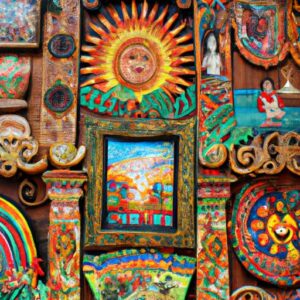Introduction
Artistic expression knows no bounds, constantly evolving and embracing new possibilities. In this digital age, the realm of traditional art has been enriched by the emergence of digital sketches. But what exactly are digital sketches, and how do they relate to traditional art? Join me on this artistic journey as we uncover the captivating world of digital sketches and the invaluable role they play in the realm of traditional art.
Digital sketches can be defined as the art of creating preliminary drawings using digital tools and software. They bring together the best of both worlds, combining the fluidity and versatility of traditional sketches with the technological advancements of the digital era. As an artist, you might wonder – why should I incorporate digital sketches into my traditional art practice?
The Benefits and Advantages of Digital Sketches
Imagine having the power to effortlessly experiment with different styles, techniques, and compositions at the tip of your stylus. Digital sketches offer unprecedented flexibility and ease of editing, allowing you to explore endless possibilities without the fear of making irreversible mistakes. With just a few clicks, you can adjust proportions, colors, and even undo any artistic missteps. It’s like having an artistic time machine at your disposal!
Not only do digital sketches save you time and increase productivity, but they also enhance your ability to achieve accuracy and precision. With the aid of digital tools, you can create clean lines, perfect shapes, and flawless details with remarkable ease. This newfound precision gives your traditional art a professional touch, elevating the overall quality of your creations.
Digital sketches also provide a platform for endless experimentation. Are you fascinated by a new art style but hesitant to try it on canvas? With digital sketches, you can fearlessly explore diverse styles, textures, and color palettes. This experimentation nurtures your artistic growth, enabling you to discover your unique voice and expand your creative horizons.
In the upcoming sections of this article, we will delve deeper into the captivating world of digital sketches for traditional art. Discover the essential tips for creating stunning digital sketches, learn how to seamlessly transfer your digital creations onto traditional art surfaces, and unveil the incredible potential of this powerful artistic fusion. Let’s embark on this artistic adventure together as we unlock the boundless possibilities of digital sketches for traditional art.
Understanding Digital Sketches
Definition and Explanation of Digital Sketches in Relation to Traditional Art
Digital sketches, in essence, are preliminary drawings created using digital tools and software. They bridge the gap between traditional art and technology, offering artists a new medium to express their creativity. Instead of wielding a pencil or brush on paper, the artist uses a digital stylus or pen to create sketches on a tablet or computer screen.
Unlike traditional sketches, digital sketches exist solely in the digital realm. They are not physical drawings on paper but rather digital files that can be saved, edited, and shared with ease. This digital format opens up a world of possibilities for artists, providing them with the ability to manipulate and refine their sketches with precision.
Comparison of Digital Sketches with Traditional Sketches
While both digital and traditional sketches share the common goal of capturing initial ideas and concepts, they differ in execution and characteristics. Traditional sketches are often created using graphite pencils, charcoal, or ink on paper or canvas. The artist’s hand movements directly translate into marks on the surface, creating a tactile and intimate connection between the artist and the artwork.
Digital sketches, on the other hand, rely on the use of digital tools and software. The stylus or pen interacts with the tablet or computer screen, replicating the sensation of drawing on paper. However, the digital medium brings added advantages, such as the ability to effortlessly erase, adjust, and experiment with various elements of the sketch.
Tools and Software Commonly Used for Creating Digital Sketches
The digital art world offers an array of tools and software specifically designed for creating digital sketches. These tools range from sophisticated graphic tablets with pressure-sensitive pens to portable tablets with built-in drawing capabilities. Popular software options include Adobe Photoshop, Procreate, SketchBook, and Clip Studio Paint, each offering unique features and functionalities to cater to different artistic needs.
These digital tools provide artists with an extensive range of brushes, colors, layers, and blending modes, allowing for unlimited creativity and artistic expression. Artists can choose from a variety of brush styles, mimicking traditional media like pencil, ink, or watercolor, as well as explore innovative digital brushes that offer textures and effects not achievable with traditional tools.
In the next section, we will uncover the advantages of incorporating digital sketches into the realm of traditional art. Buckle up as we explore the flexibility, time-saving capabilities, and precision that digital sketches bring to your artistic journey.
Advantages of Digital Sketches in Traditional Art
Flexibility and Ease of Editing in Digital Sketches
Digital sketches offer unparalleled flexibility and ease of editing, revolutionizing the way traditional artists approach their craft. Unlike traditional sketches, which often require starting from scratch or making messy adjustments, digital sketches provide a digital canvas that allows for effortless modifications. With just a few taps or strokes, you can resize, reshape, or reposition elements, ensuring that your artistic vision is flawlessly captured. Embrace the freedom to experiment, knowing that any changes can be easily undone or refined, allowing your creativity to flow unhindered.
Ability to Experiment with Different Styles and Techniques
One of the most exciting aspects of digital sketches is the ability to explore and experiment with a wide range of artistic styles and techniques. With traditional sketches, switching between styles can be challenging and time-consuming. However, in the digital realm, you can effortlessly switch between different brushes, textures, and effects, enabling you to explore new horizons and push the boundaries of your artistic expression. Embrace the opportunity to blend realism with abstraction, or try your hand at impressionism or surrealism – the possibilities are limitless.
Time-Saving Capabilities and Increased Productivity
In the fast-paced world we live in, time is a precious commodity for artists. Digital sketches come to the rescue, offering time-saving capabilities that traditional sketches simply cannot match. With digital tools, you can quickly sketch, modify, and refine your artwork, eliminating the need for laborious erasing and redrawing. This newfound efficiency boosts your productivity, allowing you to create more art in less time. Imagine the joy of completing multiple sketches in a single sitting or having more time to experiment with new techniques – digital sketches empower you to make the most of your artistic journey.
Improved Accuracy and Precision in Creating Art
Creating art with precision and accuracy is a vital aspect of artistic mastery. Digital sketches provide a platform for achieving unparalleled precision in your artwork. With the aid of digital tools, you can create clean, crisp lines, perfect shapes, and intricate details, elevating the overall quality of your traditional art. Whether you’re working on portraiture, landscapes, or still life, digital sketches allow you to achieve a level of detail that may have seemed unattainable before. Embrace the power of digital technology to enhance your artistic abilities and create breathtakingly precise masterpieces.
In the upcoming sections, we will explore essential tips for creating digital sketches for traditional art and learn how to seamlessly transfer your digital creations onto traditional art surfaces. Stay tuned as we uncover the secrets to harnessing the full potential of digital sketches in your artistic practice.
Tips for Creating Digital Sketches for Traditional Art
Are you ready to dive into the exciting world of digital sketching for traditional art? Here are some invaluable tips to help you unleash your artistic potential and create stunning digital sketches that seamlessly blend with your traditional art practice.
Choosing the Right Digital Sketching Software and Tools
The first step towards creating remarkable digital sketches is selecting the appropriate software and tools. There are numerous options available, each offering unique features and functionalities. Experiment with different software and find the one that aligns with your artistic vision and workflow. Whether it’s the industry-standard Adobe Photoshop or the versatile Procreate app, choose a tool that resonates with your artistic style.
Understanding the Features and Functionalities of the Selected Software
Once you’ve chosen your digital sketching software, take the time to familiarize yourself with its features and functionalities. Explore the various brushes, settings, and effects available to you. Understanding how to utilize layers, adjust opacity, and make use of blending modes will elevate your digital sketches to new heights. Don’t be afraid to experiment and push the boundaries of what your chosen software can do.
Utilizing Layers and Blending Modes for Better Results
Layers are a powerful tool in digital sketching that allow you to work on different elements of your artwork separately. They provide the flexibility to make changes without affecting the entire composition. Additionally, blending modes enable you to create captivating effects by seamlessly blending colors and textures. Experiment with different layer arrangements and blending modes to enhance the depth and visual impact of your digital sketches.
Incorporating Traditional Art Techniques in Digital Sketches
Digital sketching doesn’t have to be detached from traditional art techniques. Embrace the best of both worlds by incorporating traditional art techniques into your digital sketches. Experiment with brush strokes, textures, and shading techniques to create a unique blend of digital and traditional aesthetics. The fusion of these techniques will add depth and authenticity to your digital sketches, making them stand out from the crowd.
Importance of Practicing and Experimenting with Digital Sketching
As with any artistic endeavor, practice is key to mastering the art of digital sketching. Set aside dedicated time to explore different techniques, experiment with various brushes, and push your artistic boundaries. The more you practice, the more proficient you will become in using digital tools to express your artistic vision. Embrace the freedom that digital sketching offers and let your creativity soar.
In the next section, we will explore the process of transferring your digital sketches onto traditional art surfaces, bridging the gap between the digital and physical realms of art. Stay tuned as we uncover the secrets of this seamless transition.
How to Transfer Digital Sketches to Traditional Art
Techniques for Transferring Digital Sketches onto Canvas or Paper
Once you’ve created a captivating digital sketch, the next step is to transfer it onto a traditional art surface, such as canvas or paper. Fortunately, there are several techniques you can employ to accomplish this seamlessly. One popular method is using a projector to project your digital sketch onto the desired surface. By adjusting the size and position, you can precisely transfer every detail with ease. Another technique involves printing your digital sketch and using transfer paper or graphite paper to trace the image onto the traditional surface. This method works well for transferring intricate details and textures.
Importance of Proper Scaling and Proportions in the Transfer Process
When transferring your digital sketch to a traditional art surface, maintaining proper scaling and proportions is crucial. It ensures that your final artwork retains the intended composition and visual impact. Begin by determining the desired size of your traditional artwork. If using a projector, adjust the projection size to match the chosen dimensions. If using transfer paper, carefully measure and scale the printed sketch to fit your surface. Pay close attention to the proportions and ensure they remain consistent throughout the transfer process.
Methods for Tracing or Transferring the Digital Sketch onto the Traditional Art Surface
Depending on your preference and the complexity of your digital sketch, you can choose between tracing or transferring methods to bring your creation to life on a traditional art surface. Tracing involves placing a transparent sheet or tracing paper over your digital sketch and carefully tracing the lines onto the traditional surface. This method is ideal for preserving intricate details and achieving precise linework. Alternatively, you can use transfer paper or graphite paper by placing it between the printed digital sketch and the traditional surface. Applying pressure while tracing the lines will transfer the graphite or carbon onto the surface, creating an outline of your digital sketch.
Necessary Materials and Tools for Transferring Digital Sketches
To successfully transfer your digital sketch to a traditional art surface, gather the necessary materials and tools. You’ll need a projector (if using the projection method), transfer paper or graphite paper, a printer, a transparent sheet or tracing paper, and a soft pencil or pen for tracing. Ensure your printer is calibrated accurately to maintain the integrity of your digital sketch during the printing process. Additionally, choose a high-quality transfer paper or graphite paper that leaves clean and easily erasable marks. By having these materials and tools at hand, you’ll be equipped to transfer your digital sketch seamlessly onto your chosen traditional art surface.
As we near the end of our artistic journey, continue to stay with me as we delve into the final section of this article. We will recap the myriad benefits of incorporating digital sketches into your traditional art practice and leave you inspired to embrace this powerful fusion of creativity.
Conclusion
In conclusion, digital sketches have revolutionized the world of traditional art, opening up new avenues of creativity and artistic exploration. The fusion of digital technology with traditional art techniques has brought forth a plethora of benefits and advantages for artists.
Through digital sketches, artists can enjoy unparalleled flexibility and ease of editing, allowing for experimentation without the fear of irreversible mistakes. The ability to effortlessly adjust proportions, colors, and compositions empowers artists to push the boundaries of their creativity and achieve remarkable precision in their traditional art.
Moreover, digital sketches save valuable time and enhance productivity, enabling artists to bring their visions to life efficiently. The seamless transfer of digital sketches onto traditional art surfaces allows for the integration of traditional art techniques, resulting in unique and captivating creations.
As the digital landscape continues to evolve, it is crucial for artists to embrace the tools and techniques that complement their artistic journey. Digital sketches provide artists with a powerful medium to express their creativity, experiment with new styles, and refine their traditional art practice.
So, whether you are a seasoned traditional artist or an aspiring creative, consider incorporating digital sketches into your artistic repertoire. Embrace the boundless possibilities that digital sketches offer and unleash your artistic potential.
Let digital sketches be your gateway to a world of limitless exploration, where traditional art meets the cutting-edge technology of the digital era. Embrace this fusion and witness the transformative impact it can have on your artistic journey. The future of traditional art lies in the hands of those who dare to embrace innovation and push the boundaries of their creativity.
So, grab your digital tools, unleash your imagination, and embark on a mesmerizing artistic adventure with digital sketches for traditional art. The canvas of unlimited possibilities awaits, and it’s time for you to leave your indelible mark.
Remember, the only limits are the ones we impose upon ourselves. Break free from the confines of tradition and embrace the extraordinary potential of digital sketches for traditional art. Let your artistic expression soar to new heights, and let the world bear witness to the captivating beauty you create.





